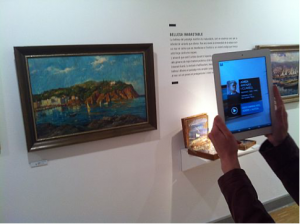20 Augmented Reality
Carrie Lewis Miller
Learning Objectives
- Differentiate between VR and AR
- Explore AR apps for use in education
Augmented reality (AR) is less immersive than virtual reality. Using a mobile device, AR makes use of apps to overlay reality with a virtual environment. Pokemon Go! is the best example of AR in recent years. AR tends to be a more affordable and manageable method of integrating technology in education and training over virtual reality because of the lack of external devices needed other than a mobile device. Apps such as Anatomy 4D and Star Chart use specific targets (printed paper targets and constellations, respectively) to determine which overlay to show the user. The user can then interact with the superimposed overlay and manipulate the virtual environment, as seen in Figure 12 where a museum patron uses an AR app to view detailed information on a painting.
 .
.
Figure 12: Augmented reality at Museu de Mataró. Kippelboy. (Photographer). (2012, April 12). Augmented reality at Museu de Mataró linking to Catalan Wikipedia articles. [digital image]. https://commons.wikimedia.org/wiki/File:Augmented_reality_at_Museu_de_Matar%C3%B3_linking_to_Catalan_Wikipedia_(25).JPG
Augmented reality has been used with success in secondary school settings. There is a noticeable lack of empirical AR studies in higher education. AR has been used to engage and motivate secondary students in Earth Science (Sahin & Yimaz, 2020); to assist individuals with special needs learn life skills, social skills, motor skills, and learning skills (Baragash et al., 2020); and to teach students about anatomy and physiology (Chytas et al., 2020). Easy-to-use platforms like Metaverse allow for the creation of personalized AR experiences.
References
Baragash, R. S., Al-Samarraie, H., Alzahrani, A. I., & Alfarraj, O. (2020). Augmented reality in special education: A meta-analysis of single-subject design studies. European Journal of Special Needs Education, 35(3), 382-397.
Chytas, D., Johnson, E., Piagkou, M., Mazarakis, A., Babis, G., Chronopoulos, E., Nikolaou, V., Lazaridis, N., & Natsis, K. (2020). The role of augmented reality in anatomical education: An overview. Annals of Anatomy, 229, 151463–151463. https://doi.org/10.1016/j.aanat.2020.151463
Sahin, D., & Yilmaz, R. M. (2020). The effect of augmented reality technology on middle school students’ achievements and attitudes towards science education. Computers & Education, 144, 103710.

